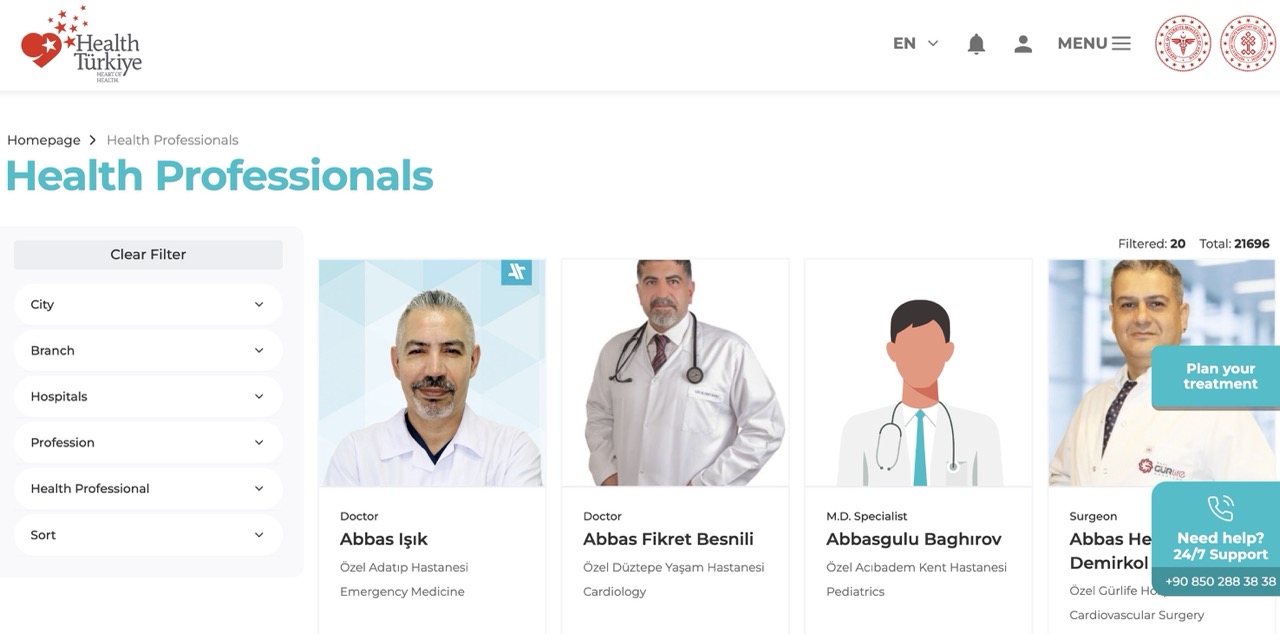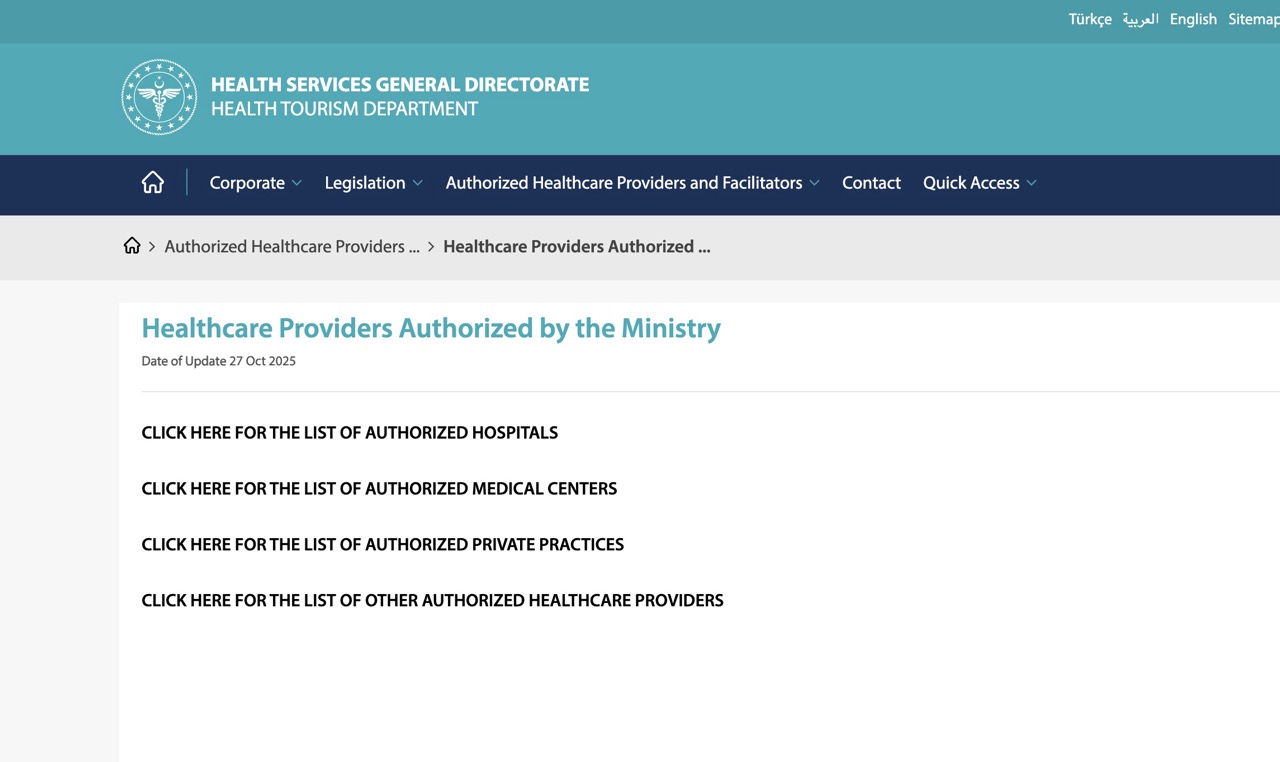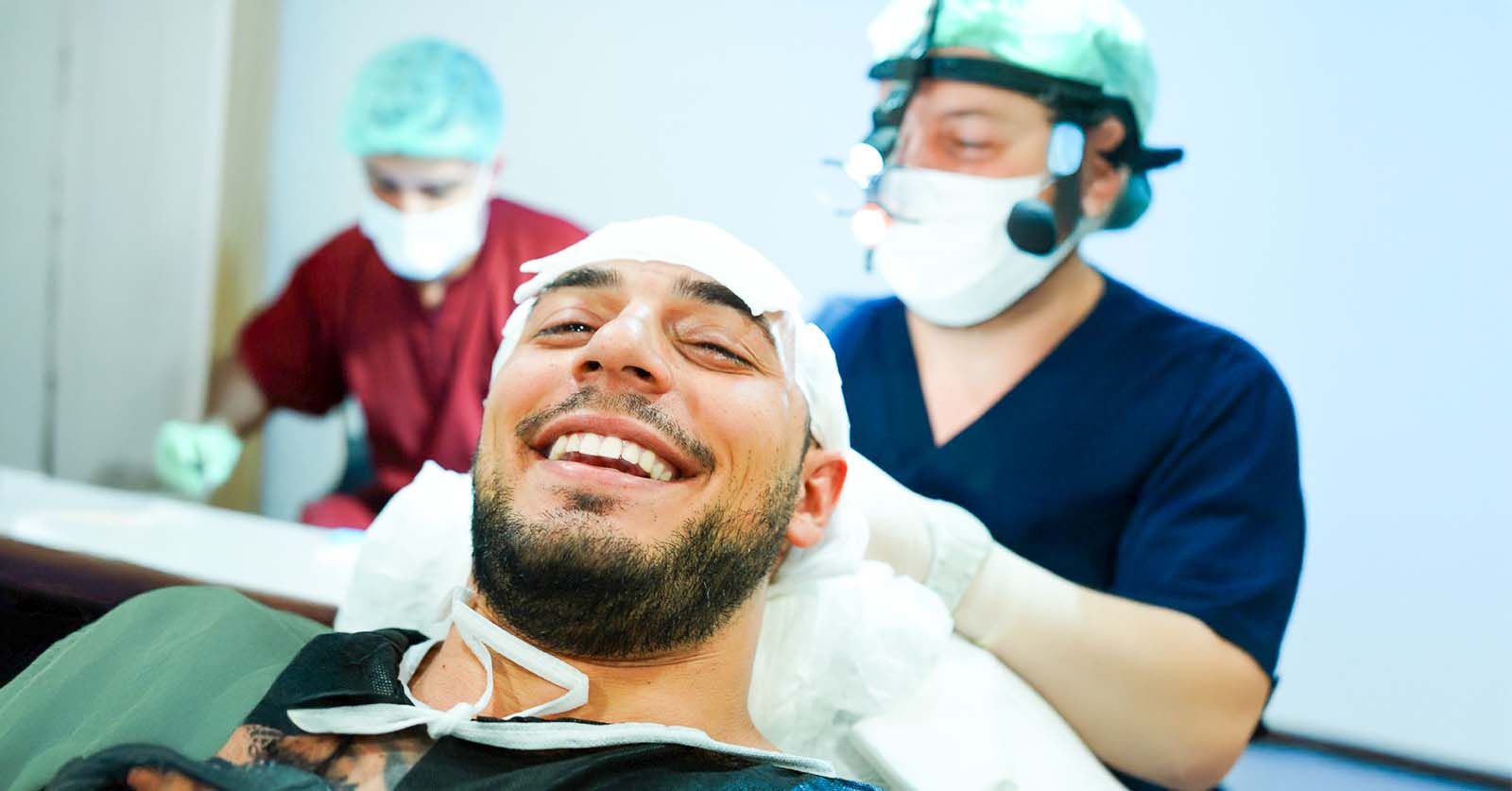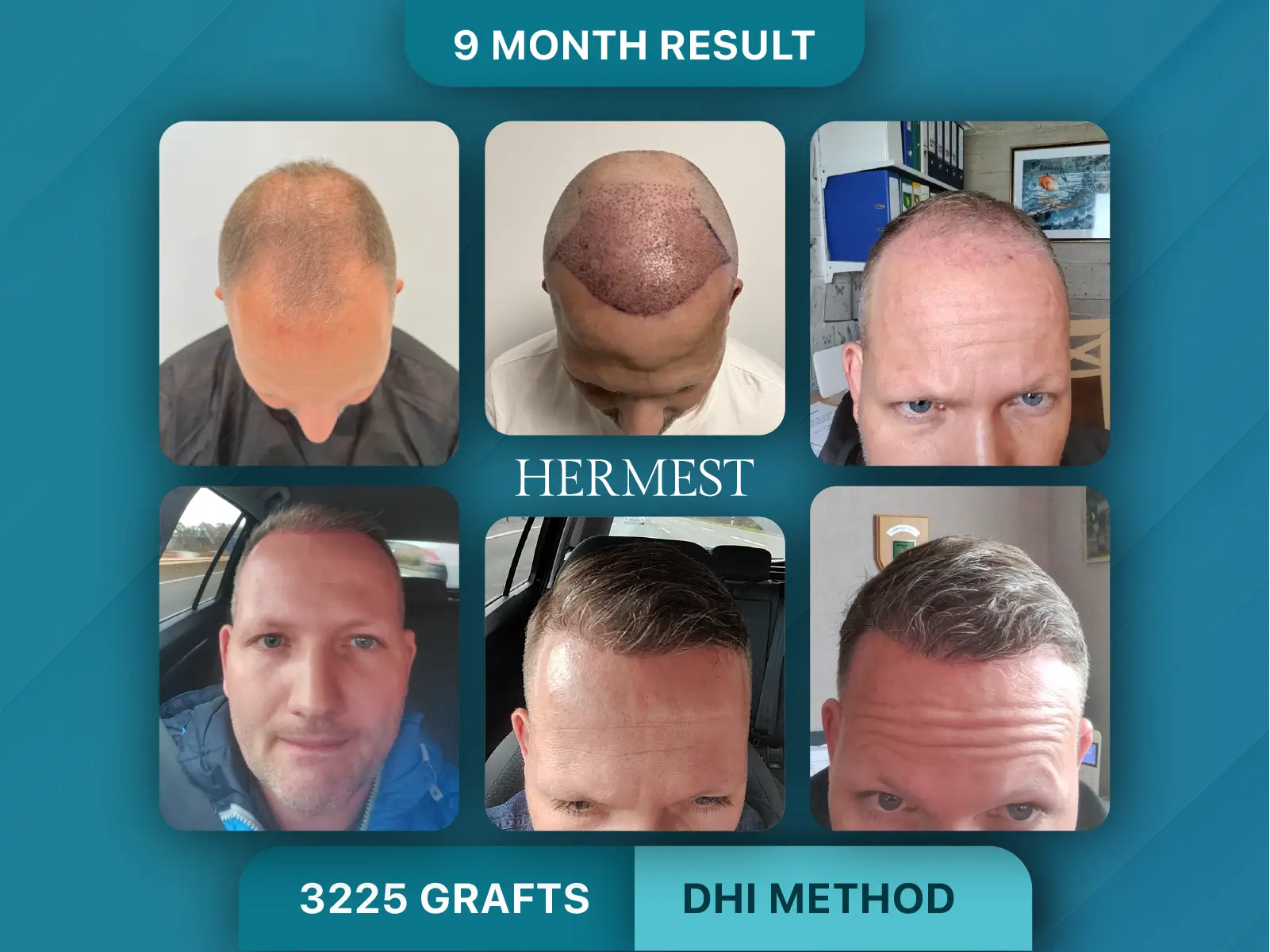Finding the best hair transplant clinic in Turkey can feel overwhelming. You’ve seen hundreds of clinics on Instagram, endless “Top 10” lists, and every ad claims to be the “most advanced”. But behind the photos and promotions, there’s a bigger question: how do you know who’s actually qualified to operate on you?
Each year, Turkey welcomes over 500,000 international patients for hair restoration, according to USHAŞ (International Health Services Inc.), the official body under the Turkish Ministry of Health that oversees medical tourism.
Turkey’s reputation is well-earned with world-class surgeons, competitive prices, and cutting-edge techniques like Sapphire FUE and DHI. But with success comes imitation, and hundreds of unlicensed centers have tried to cash in, blurring the line between real medicine and aggressive marketing.
The truth is, “best” doesn’t mean “most famous” or “most affordable.” The best clinic is one that’s licensed by the Turkish Ministry of Health, led by a qualified surgeon, and transparent about techniques, results, and pricing. It’s a medical facility, not a marketing company.
According to the International Society of Hair Restoration Surgery (ISHRS), the main factor in patient satisfaction isn’t the country or even the technique, it’s whether a licensed physician actually performs or supervises the surgery. In Turkey, this distinction can mean the difference between a life-changing result and a lifelong regret.
So before you choose based on price or social media followers, take a few minutes to learn how to verify who’s real. This guide will explore:
- How to check a clinic’s license online through the Ministry of Health.
- What questions reveal whether a doctor or technician will perform your surgery.
- The pricing red flags, fake before-and-after photos, and “package” traps to avoid.
- The practical checklist our Istanbeautiful team uses when reviewing clinics in person.
Let’s start with the most important step, how to verify that a hair transplant clinic in Turkey is officially licensed before you even send a deposit.
At a Glance: How to Find the Best Hair Transplant Clinic in Turkey
- Verify the license. Always confirm the clinic’s registration through the Turkish Ministry of Health and USHAŞ before booking.
- Choose a doctor-led team. A qualified surgeon must perform or directly supervise every stage of the procedure, not unlicensed technicians.
- Expect transparent pricing. Safe, doctor-led procedures typically cost between $2,500–$3,500 USD. Extremely low prices usually mean hidden risks.
- Match the technique to your needs. FUE: ideal for broad coverage. DHI: best for detailed, dense hairlines. Sapphire FUE: enables faster recovery. A reliable clinic will explain its recommendation based on your scalp, not a preset package.
- Look for authentic patient photos. Genuine results show donor areas, consistent lighting, and time progression (month 1, 3, 6, and 12). Avoid galleries that look identical or over-edited.
- Pay attention to the clinic environment. Licensed clinics are calm, organized, and hygienic. A noisy or crowded setup signals mass operations and lower safety.
- Aftercare is half the success. Expect detailed post-op instructions, medication guidance, and long-term remote follow-ups for at least a year.
- Know your rights as a patient. Keep all receipts, contracts, and chats. If a dispute arises, contact the Provincial Health Directorate or USHAŞ for official support.
- Trust your instincts. If a clinic feels pushy, vague, or too perfect online, walk away. Real medical professionals welcome questions and explain the process clearly.
Verify the Clinic in 2 Minutes
Before you fall for Instagram testimonials or five-star reviews, do this first: check if the clinic is licensed by the Turkish Ministry of Health (Sağlık Bakanlığı). It takes two minutes, and can save you from a lifetime of regret.
Step 1: Search the Ministry of Health Registry
Go to the official Ministry of Health “Health Professionals” database on healthturkiye.com, that this is where you can confirm hospitals, doctors, and clinics.

For “Facilitators with International Health Tourism Authorization Certificates”, find them on healthturkiye.com. It can be hard to search but you are getting familiar.

- Search the healthcare professional, hospital, agency, or the clinic’s full legal name.
- Check that the address matches what’s listed on their website.
- Make sure there’s a responsible doctor listed. That’s the person legally accountable for medical procedures performed there.
If the clinic doesn’t appear, or if the name differs slightly (“HairMed” vs “HairMedix,” for example), it’s not licensed. The Ministry issues licenses only to facilities that pass strict health inspections for sterilization, emergency equipment, and staffing.
Step 2: Confirm through USHAŞ (International Health Services Inc.)
USHAŞ, a public agency under the Ministry of Health, maintains an English-language support line and online form for international patients. They can verify if a clinic is authorized to treat foreign visitors.
- Visit the USHAŞ official website and look for the “Authorized Health Institutions” section from https://shgmturizmdb.saglik.gov.tr
- Or email their support team with the clinic’s name and city; they’ll respond within a few business days.

USHAŞ also helps resolve disputes and ensures medical tourism standards are met. In 2024, they processed over 1,200 patient verification requests, most involving hair transplant clinics in Istanbul and Ankara.

If a clinic passes the Ministry license, USHAŞ authorization, and surgeon verification, you’re dealing with a legitimate medical facility. If not, no price tag or glossy marketing should convince you otherwise.
Doctor-Led vs. Technician-Led Clinics
Here’s the question most people forget to ask: Who actually performs the surgery? In Turkey, this one detail can make or break your results, and your safety.
What a doctor-led clinic means
A doctor-led clinic is one where a licensed physician performs or directly supervises every medical step: local anesthesia, graft extraction, channel opening, and implantation. Nurses and assistants help, but the doctor remains in charge throughout.
These clinics often perform only 2–4 surgeries per day, allowing the surgeon to maintain focus and ensure graft survival. According to the ISHRS, such control directly correlates with higher graft survival rates (often above 90–95%) and more natural hairline design.
Dr. Ahmet Murat (Hermest Hair Clinic): “The doctor’s hand isn’t just for precision, it’s for protection. Every incision affects blood flow, angle, and density. That judgment can’t be delegated.”
What technician-led clinics really are
In contrast, technician-led clinics operate under a single doctor’s license but allow unqualified staff to perform key parts, sometimes the entire surgery. In these setups, one “supervising doctor” might oversee 10–15 operations a day, appearing briefly to sign forms or take photos.
The Turkish Ministry of Health strictly prohibits this practice, yet it persists in unlicensed centers. The ISHRS classifies these clinics as “black market operations”, warning that technician-performed surgeries are responsible for most international patient complaints involving scarring, infection, and poor density.
Questions to ask before booking
- Who performs the graft extraction?
- Who opens the incision channels?
- How many patients does the doctor handle per day?
- Can I meet or video call the surgeon before paying a deposit?
If you don’t get clear, direct answers, you already have your answer.
Doctor-led clinics protect both your donor area and your investment. Technician-led ones treat your scalp like a number.
Price, Packages & Contracts: What’s Normal and What’s Not
The cost of a hair transplant in Turkey can vary widely, and that’s exactly what makes pricing such a common trap. Some clinics promote “all-inclusive” packages that look irresistible, flights, hotel, transfers, even a translator. But when you peel back the details, the math often doesn’t add up.
According to USHAŞ and the Turkish Ministry of Health, the typical range for a doctor-led, licensed hair transplant in 2025 is $2,500–$3,500 USD depending on the method (FUE, DHI, or Sapphire FUE), graft count, and aftercare. Anything well below that should raise a red flag.
What transparent pricing looks like
Honest clinics will give you a written quote with:
- The doctor’s full name and registration number.
- The technique being used (FUE, DHI, Sapphire FUE).
- The estimated graft count (2,500? 4,000? It matters).
- A list of what’s included, anesthesia, aftercare kit, medications, PRP if offered.
- The clinic’s full address and contact for post-op care.
This quote must be signed and stamped, it’s part of your medical record under Ministry regulations.
The ABCS also warns that vague or verbal agreements are a top cause of medical tourism disputes. Once you’re in another country, your leverage is limited, so clarity upfront is everything.
Red flags to watch for
- “Unlimited grafts” or “VIP package” with no written numbers.
- Cash-only or cryptocurrency payments (traceability problem).
- “We’ll finalize everything when you arrive”.
- No mention of taxes or invoice (unregistered clinic).
When the pricing feels fair, the paperwork is detailed, and the surgeon’s name is printed clearly, that’s usually the first sign you’re in safe hands.
Technique Choice: FUE, DHI, or Sapphire — Which One’s Right for You?
If you’ve spent any time researching hair transplants in Turkey, you’ve probably seen these three terms everywhere: FUE, DHI, and Sapphire FUE. Every clinic seems to have its “signature method”, and every website claims theirs gives the best results.

The truth? Each technique has its place, the right choice depends on your scalp, not the clinic’s promotion.
FUE (Follicular Unit Extraction)
Still the global standard, FUE involves extracting individual grafts from the donor area and implanting them into the recipient site. It’s efficient, relatively quick, and leaves minimal scarring. According to PubMed and StatPearls (2024), FUE graft survival averages around 90–95% when performed by trained surgeons using modern tools.

FUE suits most patients, especially men with early-to-moderate hair loss and healthy donor density.
DHI (Direct Hair Implantation)
DHI uses an implanter pen to place grafts directly without opening separate incisions first. The process is slower but allows for more control over angle and depth, making it ideal for dense packing and hairline refinement. Studies in the Journal of Cutaneous and Aesthetic Surgery suggest DHI reduces graft handling time and trauma, slightly improving survival rates for delicate grafts.

The trade-off? It’s costlier and demands more surgeon time, meaning a real DHI session should always involve a doctor-led team.
Dr. Gökhan Bilgin (Smile Hair Clinic): “We choose technique by scalp, not by trend. A tool is only as good as the hand that holds it.”
Sapphire FUE
A refinement of FUE that uses sapphire-tipped blades instead of steel. These ultra-sharp tips create finer, cleaner incisions, allowing denser implantation and faster recovery. The Turkish Ministry of Health now recommends sapphire tools in licensed clinics due to their sterility and precision.

It’s especially effective for patients who want high-density restoration with minimal trauma to the skin.
How the best clinics decide
- Donor strength: determines graft count and method.
- Hairline design goals: DHI is often used for frontal zones, FUE or Sapphire for coverage.
- Budget and time: DHI takes longer and costs more; FUE covers larger areas quickly.
- Medical suitability: not all patients are candidates for every technique.
Istanbeautiful team insight: “When we asked top clinics which method they used, the best ones didn’t sell us a package, they offered a plan. They said, ‘Let’s see your scalp first.’”
If a clinic insists that one technique fits everyone or refuses to explain why they chose it, that’s your signal they’re selling a product, not providing care.
Photo Proof: Reading Before & After Results Like an Insider
A picture can be worth a thousand words, or a thousand lies. When you’re choosing a hair transplant clinic in Turkey, the gallery section is where most people decide. But here’s the truth: anyone can post a “before and after”. The real question is, whose before and after are you looking at?

According to the ABCS, over 30% of online cosmetic-surgery images are edited, staged, or taken from other clinics. The ISHRS has warned for years about “photo piracy” where clinics reuse other surgeons’ results and pass them off as their own.
Dr. Ahmet Murat (Hermest Hair Clinic): “Real results show time and imperfection. Fake ones show miracles with perfect lighting and no donor view.”
How to spot authentic photos
1. Check the donor area. A trustworthy clinic always shows the back of the head. That’s where the grafts come from, the real test of skill. If every photo hides it, ask why.
2. Look for consistency. Same lighting, same angle, same distance. If the “after” photo is taken closer, brighter, or with styled hair, it’s staged.
3. Ask for timeline photos. Real hair growth happens in phases:
- Month 1–3: Shedding (the “ugly duckling” stage)
- Month 4–6: Early regrowth
- Month 9–12: Density improves
Any “instant transformation” after one month is simply impossible.
4. Beware of template hairlines. If every patient’s new hairline looks identical, you’re not seeing artistry, you’re seeing mass production.
The quick authenticity checklist
- Donor area shown clearly
- Same lighting and camera angle
- Multiple growth-stage photos
- Natural, slightly uneven hairline (that’s realism)
- Clinic watermark or case code for traceability
If you want extra assurance, ask for short video clips or even a live patient reference. Majority of the best hair transplant clinics in Turkey are usually happy to connect you with past patients.
On-Site Quality Signals in Istanbul
You can tell a lot about a hair transplant clinic in Istanbul within the first five minutes of walking in. No medical degree required, just observation. The sights, sounds, and even the way the staff greets you reveal whether you’re in a genuine medical facility or a repackaged sales office.
Istanbeautiful team insight: “We’ve visited both. One clinic had a quiet, sterile atmosphere and a doctor reviewing patient files. Another had loud music, sales agents taking calls, and five people waiting for consultations that lasted less than ten minutes. The contrast was night and day.”
What you should see and feel
1. A medical environment, not a travel agency. Licensed clinics under the Turkish Ministry of Health operate like small hospitals. Expect clean corridors, sterilization rooms, labeled surgical waste bins, and posted hygiene certificates. Staff should wear proper uniforms, not branded polos or suits.
2. Private operating rooms. Each patient must have their own enclosed surgical suite. Shared rooms with multiple procedures happening side-by-side violate Ministry regulations and risk cross-contamination.
3. A visible doctor presence. You should meet your surgeon face-to-face before surgery. They’ll examine your scalp, mark your hairline, and explain the plan. If you’re told “the doctor will join later”, that’s a red flag.
4. Clear team coordination. Check if the same team members stay with you from consultation through surgery. High staff turnover or confusion about roles often means the clinic outsources technicians.
5. Realistic daily patient volume. Doctor-led clinics rarely handle more than 3–4 surgeries a day. If you see ten patients waiting, your surgeon won’t have time to oversee every step, and your grafts will pay the price.
According to the ISHRS Patient Safety Task Force, overcrowded “production clinics” are responsible for most cases of donor scarring and poor graft survival. Similarly, USHAŞ inspections show that licensed clinics consistently follow hygiene and patient-flow standards, something most unregistered centers fail during audits.
Dr. Gökhan Bilgin (Smile Hair Clinic): “Good clinics are calm. You can feel focus in the air, not chaos, not sales pressure. That calm is safety.”
Trust your instincts. If a clinic feels rushed, disorganized, or overly eager for payment, that’s not professionalism, it’s desperation.
Aftercare & Remote Follow-ups
Your hair transplant in Turkey doesn’t end when you leave the clinic. The truth? The first few weeks after surgery decide 80% of your results. And that’s where real clinics set themselves apart, through structured aftercare and consistent remote follow-ups.
What proper aftercare looks like
A licensed clinic should hand you a detailed post-op care plan, ideally in your language. This should cover:
- Washing instructions (usually after 48–72 hours).
- Medication schedule (antibiotic, painkiller, anti-swelling).
- Sleeping position to protect grafts.
- First PRP or check-up schedule (often at 10–14 days).
- Shedding phase expectations, yes, it’s normal to lose transplanted hairs before regrowth.
According to Healthline and PubMed clinical studies, following these steps lowers infection risks and improves graft survival rates by up to 15%. It’s not about luck, it’s about precision.
Dr. Güncel Öztürk (HairNeva Clinic): “Half of your result depends on what happens after you go home. Grafts are alive, treat them that way.”
Remote follow-ups: what good clinics do right
The best Turkish clinics stay in touch. You’ll often have a dedicated coordinator or nurse on WhatsApp for 12 months post-surgery. They’ll ask for progress photos at 1, 3, 6, and 12 months, adjusting care if needed.
USHAŞ regulations now encourage clinics treating foreign patients to provide remote support. It’s not mandatory, but the top clinics treat it as standard practice.
Keep everything documented
Keep your invoice, consent forms, medication list, and chat logs. If anything goes wrong, these documents help the Provincial Health Directorate (İl Sağlık Müdürlüğü) or USHAŞ handle your complaint efficiently.
Your post-op care isn’t just follow-up, it’s part of your medical treatment. When a clinic keeps checking in long after you’ve flown home, that’s not just professionalism. It’s proof that they care about the outcome, not just the payment.
If Something Goes Wrong — Escalation Path & Patient Rights
Even with careful research, things can occasionally go wrong, a patchy result, poor follow-up, or a clinic that stops responding after you’ve paid. The good news? Turkey’s Ministry of Health takes patient protection seriously, and you do have official channels for help.
Step 1: Contact the clinic in writing
Start with a formal written complaint to the clinic (email or registered letter). Keep it calm and factual: what happened, when, and what you want resolved. Most reputable clinics will try to fix the issue, they know unresolved complaints risk their license.
Step 2: Provincial Health Directorate (İl Sağlık Müdürlüğü)
If the clinic doesn’t respond within a reasonable time, contact the Provincial Health Directorate in the city where your surgery took place (e.g., Istanbul). They handle licensing compliance and patient safety.
- Include your invoice, consent form, photos, and messages.
- Explain clearly what went wrong and when.
- They will investigate whether procedures followed Ministry standards.
Step 3: USHAŞ
USHAŞ (International Health Services Inc.), an agency under the Turkish Ministry of Health, offers an English-speaking help desk for foreign patients.
- You can submit complaints or verification requests through their website or by email.
- They liaise with clinics and health authorities to mediate disputes.
Step 4: Keep everything documented
Save:
- Payment receipts and bank transfers
- Emails and WhatsApp chats
- Pre- and post-op photos
- Any written promises about graft count or results
This evidence allows Turkish authorities to confirm malpractice or false advertising.
Important Questions & Answers
How do I confirm if a hair transplant clinic in Turkey is licensed?
Visit the USHAŞ website and check the “Healthcare Providers Authorized by the Ministry” database. There find out the provider, clinic, hospital or doctor name. If it’s not listed, it’s not authorized.
What’s the average cost of a doctor-led hair transplant in Turkey?
A fair, Ministry-licensed price range is usually $2,500–$3,500 USD depending on technique and graft count. Anything drastically cheaper likely cuts corners, often technician-led, shared rooms, or non-sterile environments.
Are low-cost “package deals” safe?
Packages can be convenient, but be cautious. Some bundle hotels and airport transfers with unlicensed clinics. Confirm that the medical facility itself is licensed, not just the travel company offering the deal.
How do I know if a clinic’s photos are real?
Check for identical lighting, consistent angles, and clear donor-area shots. Real clinics show multiple stages (month 1, 3, 6, 12). If every photo looks identical or too perfect, it’s likely edited or borrowed.
Can women and Afro-textured hair be treated in Turkey?
Yes, many Turkish clinics now specialize in female hair restoration and Afro-textured grafts, using modified FUE tools and customized angles. Always confirm that the clinic has experience with your hair type before booking.
What if I regret my results or suspect malpractice?
Contact the Provincial Health Directorate (İl Sağlık Müdürlüğü) where your surgery took place and submit your documentation (consent form, receipts, photos). International patients can also file a complaint via USHAŞ, which mediates such cases under the Ministry of Health.
Are follow-ups included after surgery?
Yes, reputable clinics provide 12-month remote support, often via WhatsApp or email. You’ll send periodic photos for review. If a clinic disappears after surgery, that’s a red flag.
Is Turkey really safe for hair transplants in 2026?
Absolutely, when done by licensed, doctor-led clinics. According to USHAŞ 2025 data, Turkey maintains one of the highest patient satisfaction rates in global medical tourism, with over 98% of verified clinics passing Ministry inspections.
Our Picks of the Best Hair Transplant Clinics in Turkey
After visiting, interviewing, and observing dozens of clinics across Istanbul and beyond, we’ve curated our own selection of the best hair transplant clinics in Turkey, the ones that genuinely combine medical integrity, advanced technique, and patient trust.
Our choices aren’t based on sponsorships or paid placements, they come from first-hand experience, patient feedback, and verified credentials.
You can explore the full list, including detailed overviews of each clinic, their lead surgeons, treatment methods, and patient insights, on our dedicated guide: Best Hair Transplant Clinics in Turkey